本页面深入概述了 InTraSeq 技术、它如何增强您的单细胞分析研究以及产品供应。
使用这些链接跳转到您感兴趣的主题。
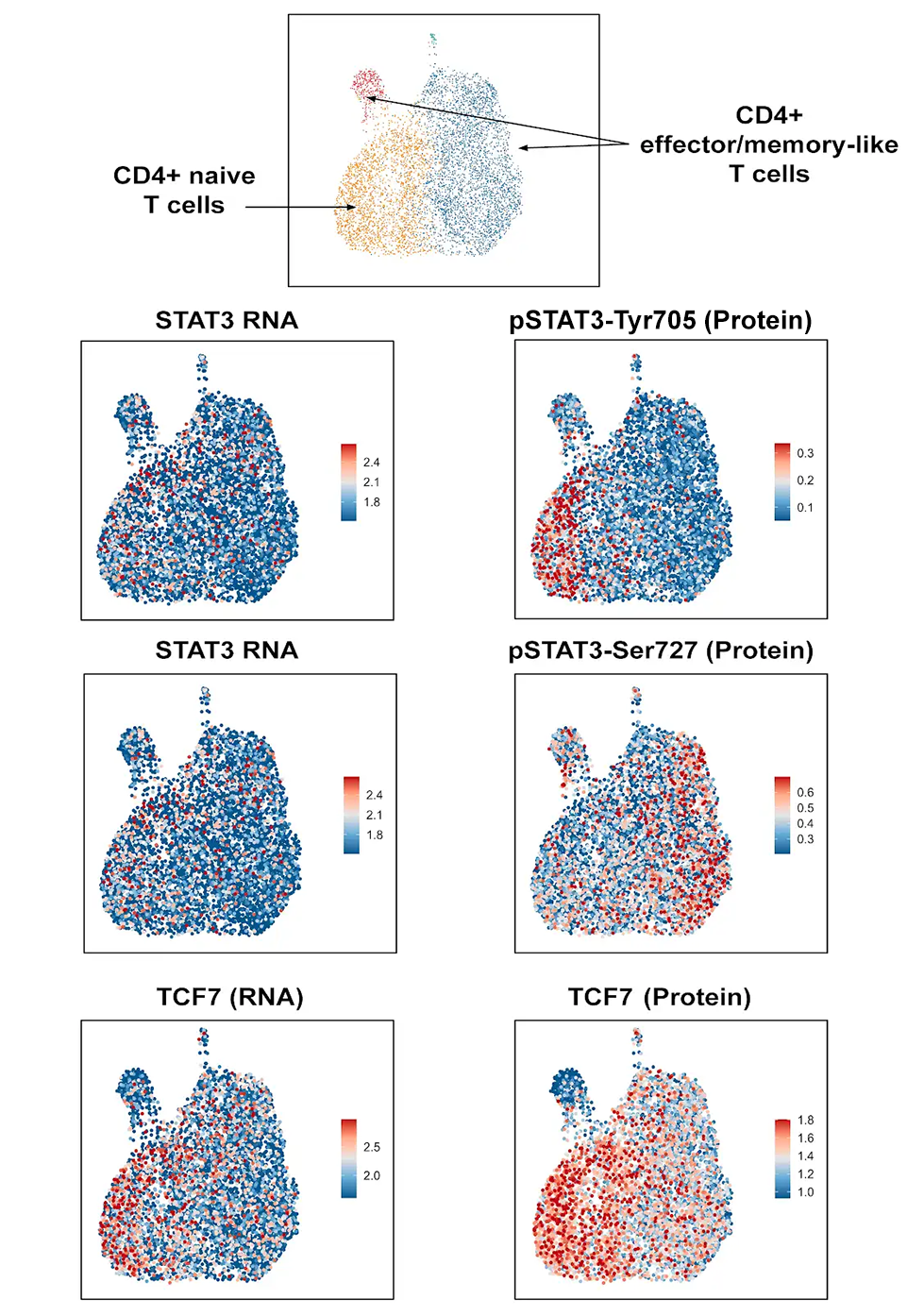 |
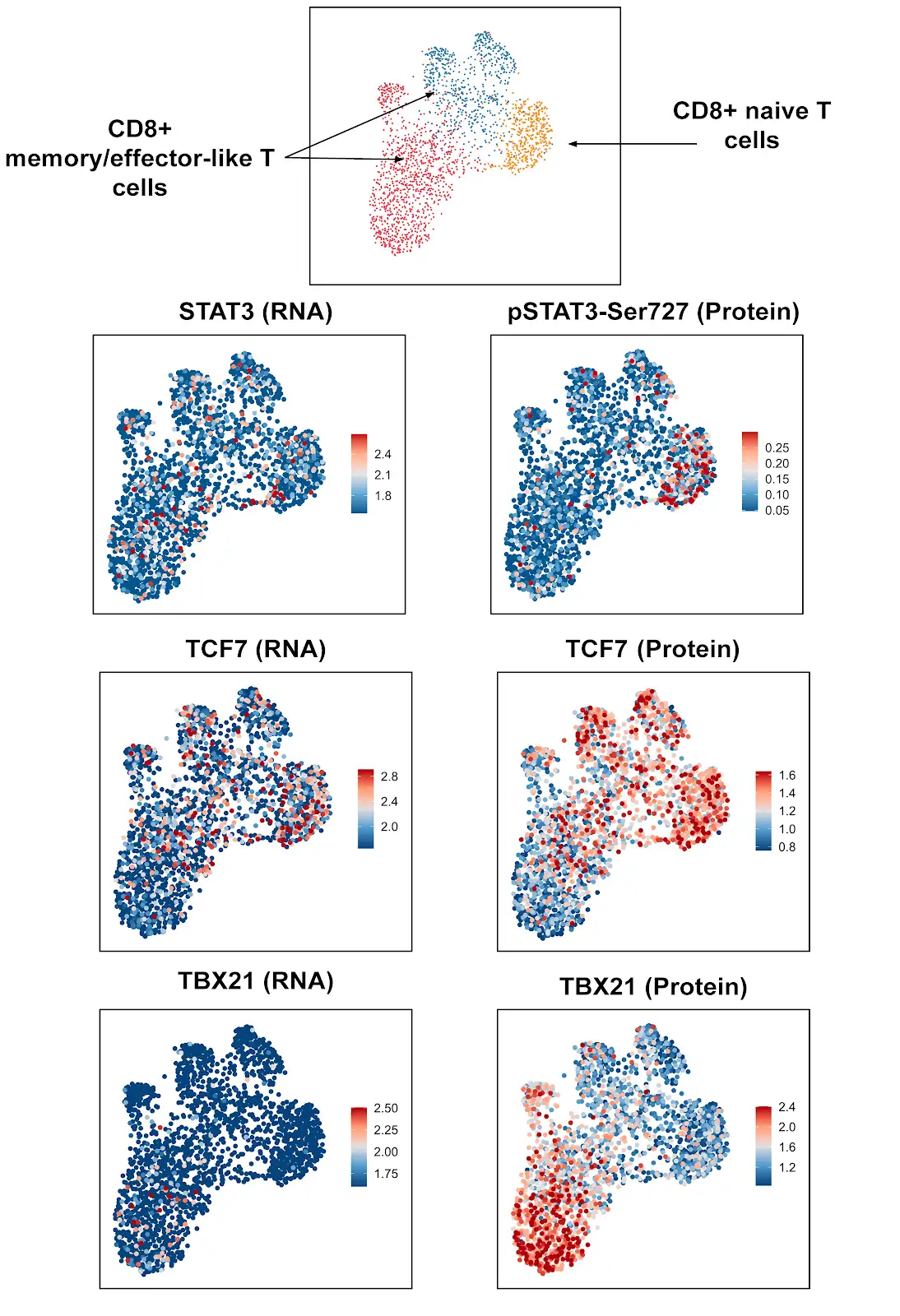 |
细胞内蛋白质和转录组测序 (InTraSeq)是 CST 开发的一种单细胞分析技术,可以在单个实验中识别信号转导通路并揭示疾病发展中的分子机制。它能够同时检测数千个细胞中的 RNA 以及细胞内和表面蛋白质,使研究人员能够在单细胞分辨率下研究信号转导通路与转录组。
InTraSeq 通过以下方式促进对细胞生物学的更深入了解:
InTraSeq 3’技术由 CST 开发和验证,采用带有特征条形码技术的 10x Genomics Chromium Single Cell 3'试剂盒。

目前大多数可用的单细胞分析技术仅限于对样本进行表型分析,因为它们只能识别 RNA 以及偶尔的表面标志表达水平。此外,其他技术无法确定和测量在疾病状态下或药物扰动时激活的重要信号级联。通过将转录组、蛋白质和翻译后修饰定量结合到单个检测中,InTraSeq 技术超越了表型分析,剖析了区分细胞差异的细胞机制——所有这些都在一次实验中完成。借助 InTraSeq 技术,科学家可以轻松探索多种信号转导通路以及基因表达变化,以有效识别生理反应背后的关键分子机制并辨别下游蛋白质修饰。
单细胞 RNA 测序 (scRNA-seq) 通常用于确定细胞对药理和环境扰动的反应。然而,蛋白质表达水平通常与 RNA 表达并不直接相关,从而导致对复杂生理系统的理解存在不足。确定单细胞蛋白质表达和翻译后修饰与单细胞基因表达的差异,可以为通路激活提供更深层次的功能性见解,而这些见解仅通过 scRNA-seq 是无法获得的。
翻译后修饰 (PTM) 可以改变蛋白质活性、寿命和表达水平。了解基因表达和蛋白质活性之间的相互作用,对于确定复杂生物系统的潜在细胞异质性和功能状态至关重要。InTraSeq 3' 偶联抗体混合物采用 31 种我们最受欢迎的抗体配制而成,可与人和小鼠靶标结合,包括 PTM。科学家可以在一次测定中轻松、无偏差地量化数十种关键信号转导蛋白。
许多细胞可以表现出相似的 RNA 表达水平,但有些细胞在蛋白质的最终表达以及随后的修饰方面可能有所不同,从而调节药理或环境扰动后的活性。对 RNA、蛋白质和翻译后修饰的共同量化有助于更彻底地理解 RNA 表达本身无法阐明的复杂生理相互作用。
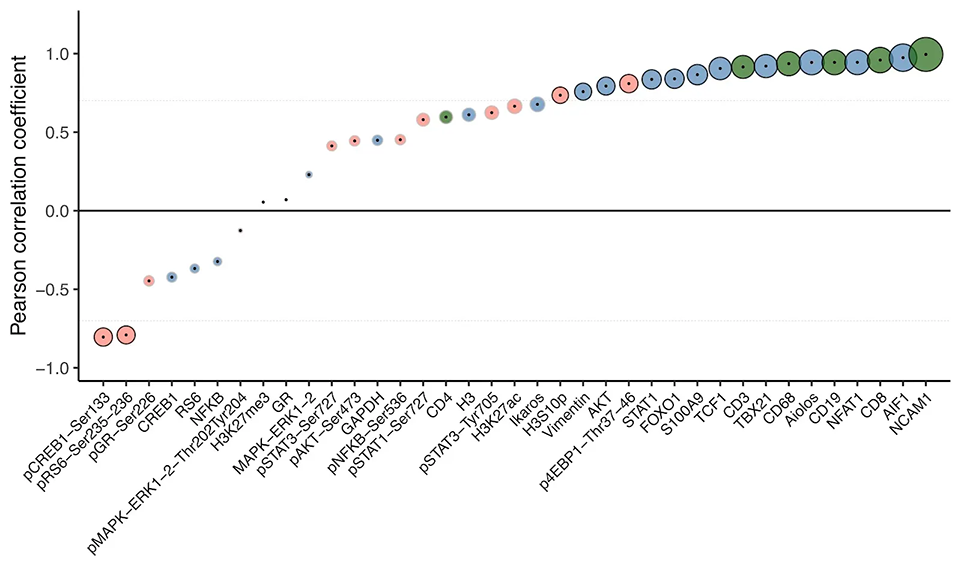
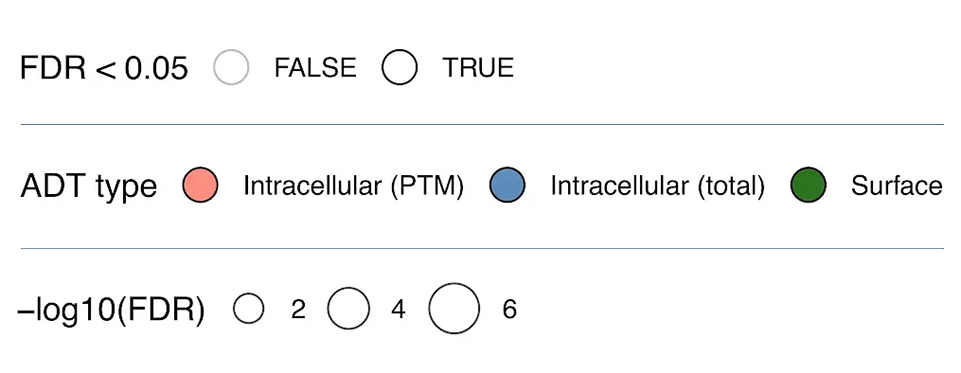
通过简化的工作流程减少实际操作时间

InTraSeq 实验步骤需要大约一小时的动手操作时间,并包括多个停顿点,使得在进行单细胞实验时可以最大限度地灵活安排时间。固定步骤后,样本可以存储长达七天,而不会损害 RNA 的完整性。与目前可用的单细胞分析实验步骤不同,InTraSeq 提供的便利性消除了协调工作人员和设备进行长时间单日实验操作的需求。样本可以存储更长时间的能力还可以促进高通量应用,因为这样可以在连续几天内执行大量样本和单细胞处理实验步骤,而不会影响质量。
简单的免疫染色实验步骤包括以下步骤:
第 1 步: 将细胞固定过夜。
第 2 步: 与 scBlock 一起孵育。
第 3 步: 添加 CST® InTraSeq™ 3’偶联抗体混合物,孵育过夜。
第 4 步: 清洗细胞。
研究细胞内蛋白质信号转导,同时保证稳定的 RNA 信号
在单细胞多组学实验中,保持 RNA 完整性一直是一个持续而重大的挑战。许多单细胞分析利用刺激性化学物质破坏膜,从而导致 RNA 降解和丢失。InTraSeq 试剂经过严格优化,可以温和地通透细胞和核膜。这使得结合抗体能够进入细胞并与其目标结合,同时在整个检测过程中保持 RNA 水平。这使得 RNA 和蛋白质的表达能够准确定量。
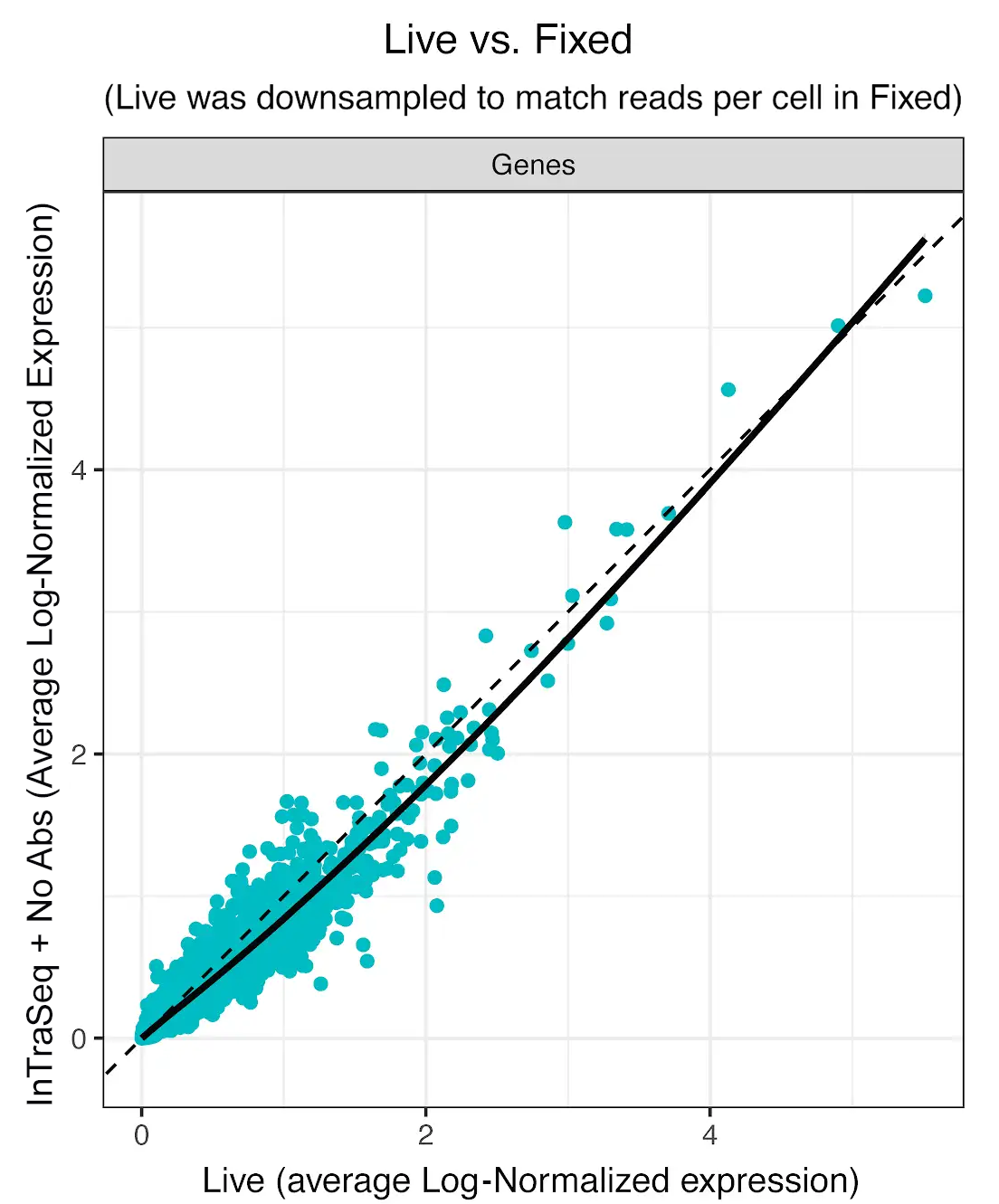 |
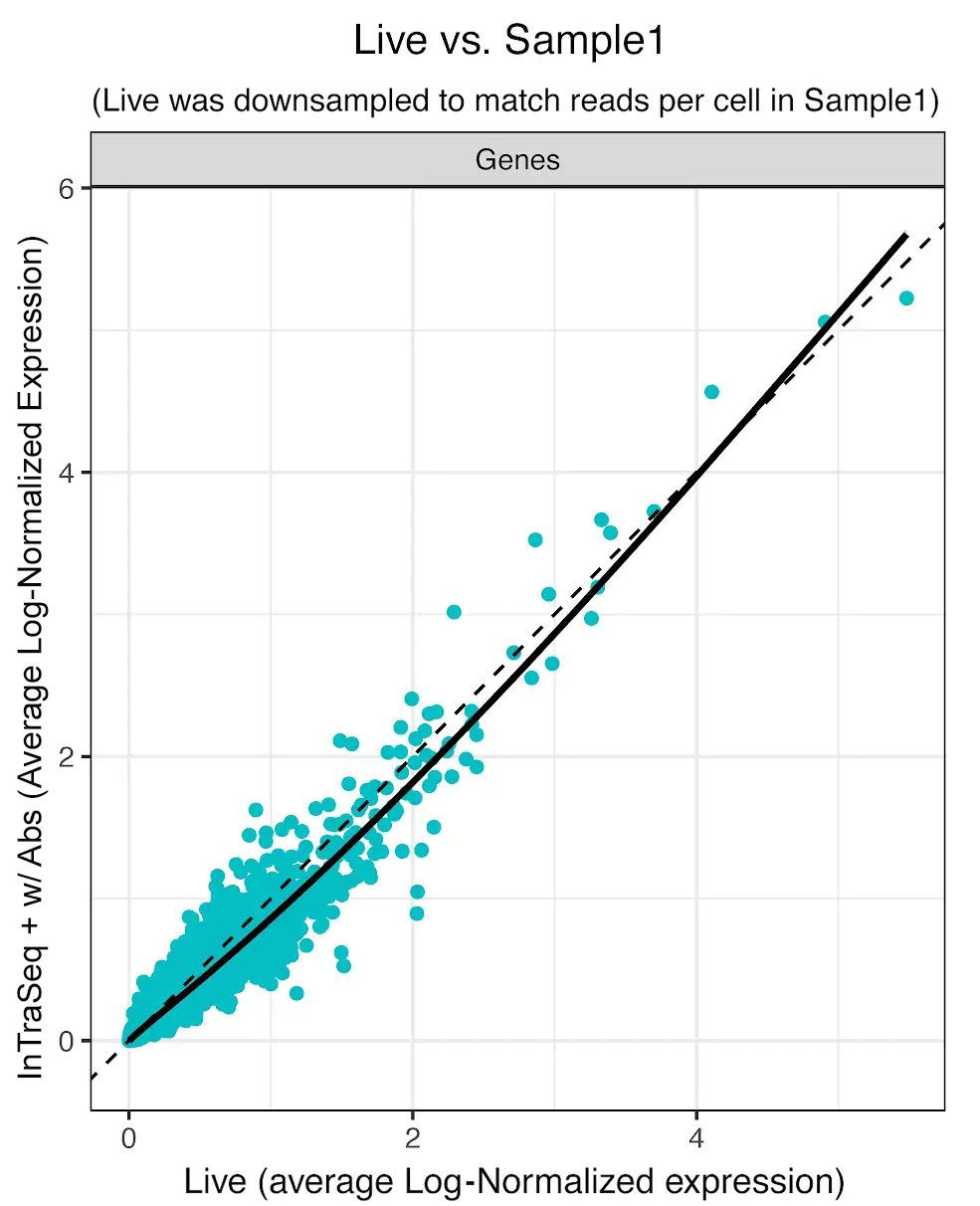 |
| Live PBMCs | InTraSeq™ PBMC | |
|---|---|---|
| Relative Median Genes/Cell (matched reads/cell) | 100% | 86.2% |
| Fraction Reads in Cells | 94.9% | 85% |
| Antibody Reads in Cells | N/A | 60% |
| Reads Mapped Confidently to Genome | 89.9% | 85.5% |
利用无偏覆盖深度识别难以检测的细胞
InTraSeq 单细胞分析技术的强大之处在于能够检测和量化细胞内和表面蛋白质,并结合单细胞基因表达,以有效区分异质细胞群。与仅检测细胞表面蛋白的 CITE-Seq 相比,InTraSeq 为科学家提供了无偏倚地研究复杂的细胞内信号转导通路的工具。
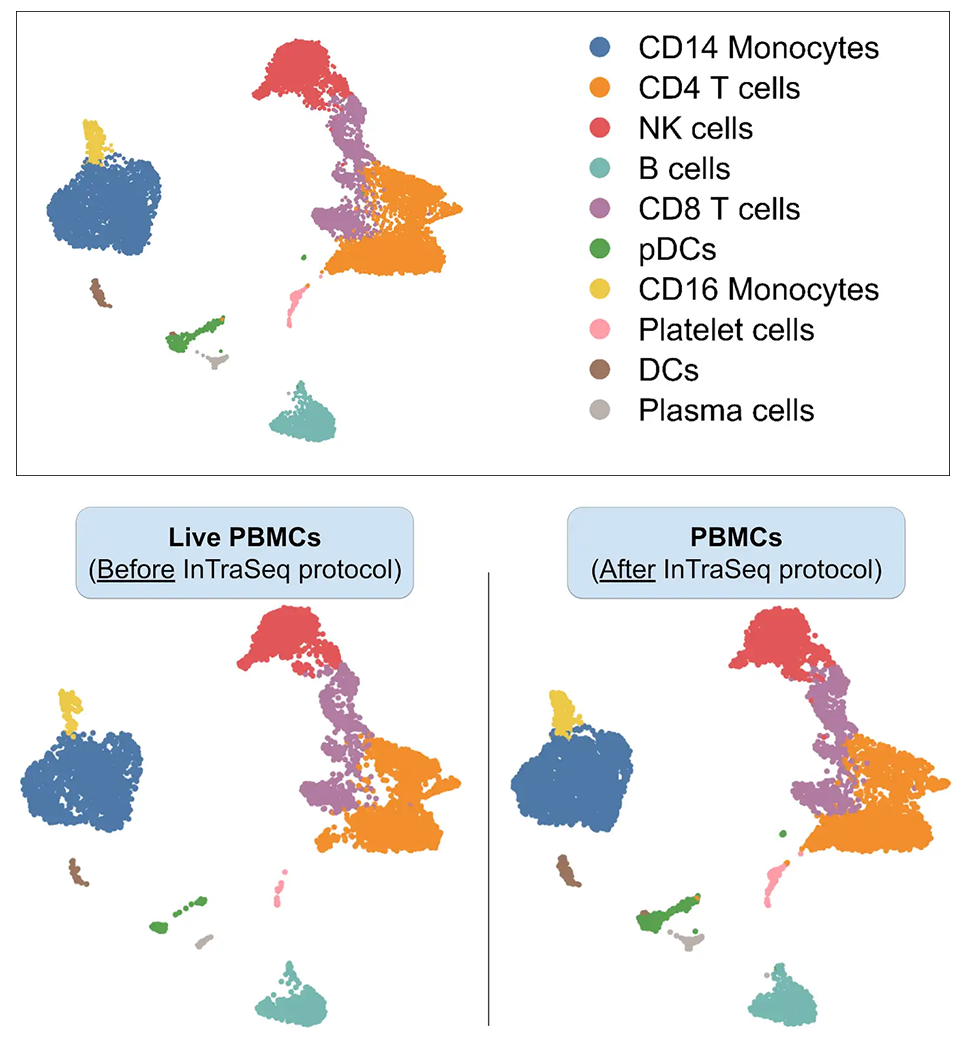
在一次实验中探索多种分子机制
结合 CST 在细胞内信号转导和翻译后修饰抗体方面的专业知识,InTraSeq 技术使研究人员能够研究和量化复杂的细胞内、细胞核和表面蛋白质相互作用以及基因表达。同时测量转录组学变化和蛋白质表达(包括翻译后修饰)可以生成更全面的数据集,以其他检测方法无法实现的方式丰富对复杂信号转导系统的认识,并加深我们对疾病机制的理解。
 |
 |
在 InTraSeq3' 偶联抗体混合物中 31 种经过验证的抗体中,有 2 种靶向表面蛋白,另外 29 种靶向细胞内蛋白,包括 PTM。抗体混合物旨在对免疫学和癌症研究中常见的信号转导通路上的蛋白质进行无偏定量,提供准确可靠的数据集。
 |
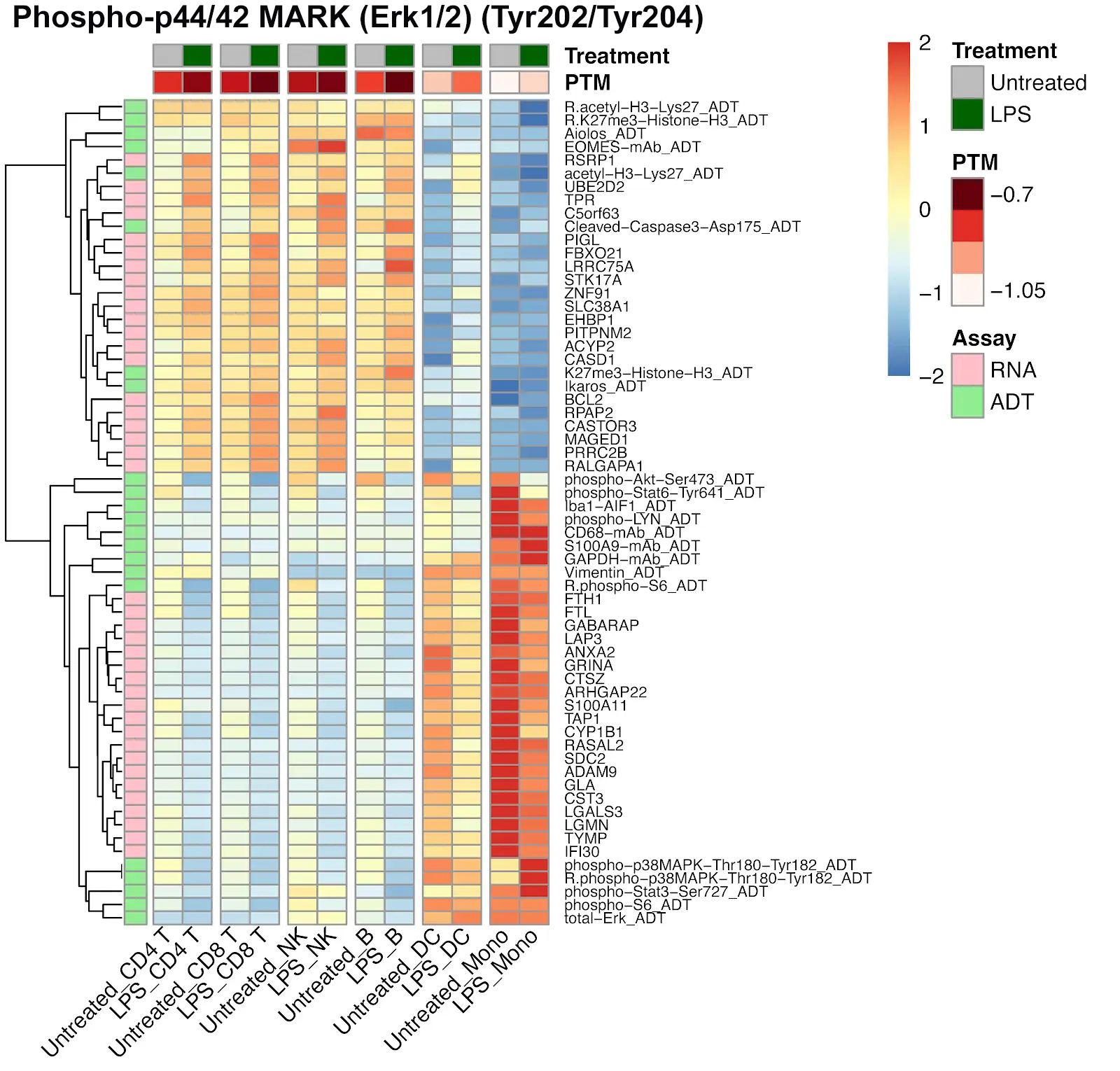 |
在启动一个项目时,InTraSeq 可以成为一个独特且强大的筛选工具。它通过提供一种公正的方法来判断哪条信号转导通路受到干扰,并有助于确定关注点,从而使研究人员能够了解特定的遗传表型。
由于 PTM 反应发生在 mRNA 之前,因此 InTraSeq 还可以测量短时间内(< 20 几分钟)发生的急性细胞扰动。这些急性反应在单细胞的 RNA 中是无法单独观察到的,这突显了 InTraSeq 技术的重要性和独特性。
凭借经 CST 验证的 InTraSeq™ 3' 偶联抗体混合物,您可完全信赖您的实验结果
CST 科学家对所有 InTraSeq 抗体和试剂进行了严格验证和优化,以确保提供一致的高质量结果。InTraSeq™ 3' 偶联抗体混合物 的配方使得所有包含的抗体和试剂都达到最佳浓度并可直接用于您的实验。InTraSeq 消除了不确定性,使科学家无需进行耗时的优化实验即可收集可靠的数据。
在下面找到用于您工作流程的正确解决方案。
包含针对常见信号通路蛋白的 31 种一抗,并且能够与人和小鼠样本发生反应。
专为单细胞分析配制的缓冲液套装。
除了 InTraSeq 3' Conjugate Antibody Cocktail 1(人和小鼠反应性)中包含的三十一种 3' 偶联抗体外,还可单独提供另外七种 InTraSeq 3' 偶联物(人反应性)。
| 产品货号 | 表面靶标 | 物种反应性 | 已包含在抗体混合物中? |
|---|---|---|---|
| #72489 | CD3 (UCHT1) Mouse mAb (InTraSeq™ 3' Conjugate 3028) | H | 否 |
| #87589 | CD4 (RPA-T4) Mouse mAb (InTraSeq™ 3' Conjugate 3029) | H | 否 |
| #25292 | CD8α (SK1) Mouse mAb (InTraSeq™ 3' Conjugate 3030) | H | 否 |
| #76014 | CD19 (Intracellular Domain) (D4V4B) XP® Rabbit mAb (InTraSeq™ 3' Conjugate 3010) | H, M | 是 |
| #29105 | CD68 (D4B9C) XP® Rabbit mAb (InTraSeq™ 3' Conjugate 3012) | H | 否 |
| #17655 | NCAM1 (CD56) (E7X9M) XP® Rabbit mAb (InTraSeq™ 3' Conjugate 3025) | H, M | 是 |
| #57412 | T-bet/TBX21 (D6N8B) XP® Rabbit mAb (InTraSeq™ 3' Conjugate 3009) | H | 否 |
| 细胞内靶标(非 PTM) | 物种反应性 | 已包含在抗体混合物中? | |
|---|---|---|---|
| #61429 | Aiolos (D1C1E) Rabbit mAb #15103 (InTraSeq™ 3' Conjugate 3027) | H, M | 是 |
| #45300 | FoxO1 (C29H4) Rabbit mAb (InTraSeq™ 3' Conjugate 3037) | H, M | 是 |
| #27907 | GAPDH (14C10) Rabbit mAb (InTraSeq™ 3' Conjugate 3007) | H, M | 是 |
| #82746 | Iba1/AIF-1 (E4O4W) XP® Rabbit mAb (InTraSeq™ 3' Conjugate 3003) | H, M | 是 |
| #42531 | Ikaros (D6N9Y) Rabbit mAb #14859 (InTraSeq™ 3' Conjugate 3026) | H, M | 是 |
| #53722 | NFAT1 (D43B1) XP® Rabbit mAb (InTraSeq™ 3' Conjugate 3032) | H, M | 是 |
| #97056 | S100A9 (D5O6O) Rabbit mAb (InTraSeq™ 3' Conjugate 3004) | H | 否 |
| #44070 | TCF1/TCF7 (C63D9) Rabbit mAb (InTraSeq™ 3' Conjugate 3013) | H, M | 是 |
| #96524 | Vimentin (D21H3) XP® Rabbit mAb (InTraSeq™ 3' Conjugate 3011) | H, M | 是 |
| PTM 相关靶标 | 物种反应性 | 已包含在抗体混合物中? | |
|---|---|---|---|
| #45003 | Phospho-4E-BP1 (Thr37/46) (236B4) Rabbit mAb (InTraSeq™ 3' Conjugate 3021) | H, M | 是 |
| #35123 | Akt (pan) (C67E7) Rabbit mAb (InTraSeq™ 3' Conjugate 3018) | H, M | 是 |
| #53639 | Phospho-Akt (Ser473) (D9E) XP® Rabbit mAb (InTraSeq™ 3' Conjugate 3014) | H, M | 是 |
| #41320 | CREB (48H2) Rabbit mAb (InTraSeq™ 3' Conjugate 3008) | H, M | 是 |
| #95580 | Phospho-CREB (Ser133) (87G3) Rabbit mAb (InTraSeq™ 3' Conjugate 3006) | H, M | 是 |
| #25504 | Glucocorticoid Receptor (D6H2L) XP® Rabbit mAb (InTraSeq™ 3' Conjugate 3035) | H, M | 是 |
| #25665 | Phospho-Glucocorticoid Receptor (Ser226) (D9D3V) Rabbit mAb (InTraSeq™ 3' Conjugate 3036) | H, M | 是 |
| #27234 | Acetyl-Histone H3 (Lys27) (D5E4) XP® Rabbit mAb (InTraSeq™ 3' Conjugate 3020) | H, M | 是 |
| #92612 | Phospho-Histone H3 (Ser10) (D2C8) XP® Rabbit mAb (InTraSeq™ 3' Conjugate 3024) | H, M | 是 |
| #53207 | Tri-Methyl-Histone H3 (Lys27) (C36B11) Rabbit mAb (InTraSeq™ 3' Conjugate 3017) | H, M | 是 |
| #76695 | NF-κB p65 (D14E12) XP® Rabbit mAb (InTraSeq™ 3' Conjugate 3033) | H, M | 是 |
| #97410 | Phospho-NF-κB p65 (Ser536) (93H1) Rabbit mAb (InTraSeq™ 3' Conjugate 3034) | H, M | 是 |
| #79941 | p44/42 MAPK (Erk1/2) (137F5) Rabbit mAb (InTraSeq™ 3' Conjugate 3016) | H, M | 是 |
| #76939 | Phospho-p44/42 MAPK (Erk1/2) (Thr202/Tyr204) (197G2) Rabbit mAb (InTraSeq™ 3' Conjugate 3023) | H, M | 是 |
| #38889 | S6 Ribosomal Protein (54D2) Mouse mAb (InTraSeq™ 3' Conjugate 3005) | H, M | 是 |
| #92243 | Phospho-S6 Ribosomal Protein (Ser235/236) (D57.2.2E) XP® Rabbit mAb (InTraSeq™ 3' Conjugate 3019) | H, M | 是 |
| #41599 | Stat1 (D1K9Y) Rabbit mAb (InTraSeq™ 3' Conjugate 3038) | H, M | 是 |
| #82887 | Phospho-Stat1 (Ser727) (D3B7) Rabbit mAb (InTraSeq™ 3' Conjugate 3039) | H, M | 是 |
| #68474 | Stat3 (124H6) Mouse mAb (InTraSeq™ 3' Conjugate 3022) | H, M | 是 |
| #69098 | Phospho-Stat3 (Tyr705) (D3A7) XP® Rabbit mAb (InTraSeq™ 3' Conjugate 3015) | H, M | 是 |
| #34774 | Phospho-Stat3 (Ser727) (D4X3C) Rabbit mAb (InTraSeq™ 3' Conjugate 3031) | H, M | 是 |
| 同型对照 | 物种反应性 | 已包含在抗体混合物中? | |
|---|---|---|---|
| #59605 | Mouse (G3A1) mAb IgG1 Isotype Control (InTraSeq™ 3' Conjugate 3001) | H | 否 |
| 检测试剂盒中包含的对照品(不适用于单独销售) | 物种反应性 | 已包含在抗体混合物中? | |
|---|---|---|---|
| #82906 | Histone H3 (D1H2) XP® Rabbit mAb (InTraSeq™ 3' Conjugate 3002) | H, M | 否 |
| #82906 | Rabbit (DA1E) mAb IgG XP® Isotype Control (InTraSeq™ 3' Conjugate 3000) | H, M | 否 |
访问技术支持页面,搜索与 InTraSeq 单细胞分析相关的疑难问题解答信息、技术问题的解决方案,以及联系我们的方式。
在细胞生物学领域,单细胞分析是指对单个细胞进行基因组学、转录组学、蛋白质组学、代谢组学及细胞间相互作用的研究,这与传统研究大量细胞群体的分析方法形成鲜明对比。
单细胞分析的主要优势在于能够识别难以检测的细胞、揭示细胞异质性特征,并解析单个细胞与其微环境的相互作用机制。
单细胞分析研究中使用的主流技术包括 CITE-seq、RNA 测序 (RNA-seq) 和单细胞 RNA 测序 (scRNA-seq)。
CITE-seq 全称为“转录组与表位测序细胞索引技术”,是一种单细胞生物学技术,可使研究人员同步检测单个细胞的 RNA 表达(转录组)和表面蛋白表达(表位),从而在基因与蛋白双维度提供细胞状态的完整图谱。
RNA 测序 (RNA-seq) 与单细胞 RNA 测序均通过分析生物样本中的 RNA 分子来研究细胞应答机制。RNA-seq 针对细胞群体进行 RNA 分析,scRNA-seq 则在单细胞水平进行 RNA 检测。